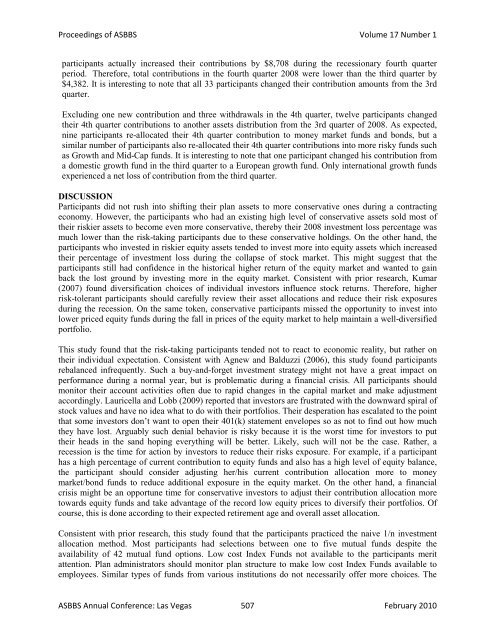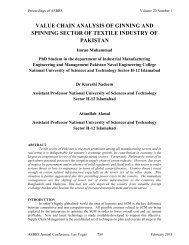HOW DOES A FINANCIAL CRISIS AFFECT 401(k ... - Asbbs.org
HOW DOES A FINANCIAL CRISIS AFFECT 401(k ... - Asbbs.org
HOW DOES A FINANCIAL CRISIS AFFECT 401(k ... - Asbbs.org
You also want an ePaper? Increase the reach of your titles
YUMPU automatically turns print PDFs into web optimized ePapers that Google loves.
Proceedings of ASBBS Volume 17 Number 1participants actually increased their contributions by $8,708 during the recessionary fourth quarterperiod. Therefore, total contributions in the fourth quarter 2008 were lower than the third quarter by$4,382. It is interesting to note that all 33 participants changed their contribution amounts from the 3rdquarter.Excluding one new contribution and three withdrawals in the 4th quarter, twelve participants changedtheir 4th quarter contributions to another assets distribution from the 3rd quarter of 2008. As expected,nine participants re-allocated their 4th quarter contribution to money market funds and bonds, but asimilar number of participants also re-allocated their 4th quarter contributions into more risky funds suchas Growth and Mid-Cap funds. It is interesting to note that one participant changed his contribution froma domestic growth fund in the third quarter to a European growth fund. Only international growth fundsexperienced a net loss of contribution from the third quarter.DISCUSSIONParticipants did not rush into shifting their plan assets to more conservative ones during a contractingeconomy. However, the participants who had an existing high level of conservative assets sold most oftheir riskier assets to become even more conservative, thereby their 2008 investment loss percentage wasmuch lower than the risk-taking participants due to these conservative holdings. On the other hand, theparticipants who invested in riskier equity assets tended to invest more into equity assets which increasedtheir percentage of investment loss during the collapse of stock market. This might suggest that theparticipants still had confidence in the historical higher return of the equity market and wanted to gainback the lost ground by investing more in the equity market. Consistent with prior research, Kumar(2007) found diversification choices of individual investors influence stock returns. Therefore, higherrisk-tolerant participants should carefully review their asset allocations and reduce their risk exposuresduring the recession. On the same token, conservative participants missed the opportunity to invest intolower priced equity funds during the fall in prices of the equity market to help maintain a well-diversifiedportfolio.This study found that the risk-taking participants tended not to react to economic reality, but rather ontheir individual expectation. Consistent with Agnew and Balduzzi (2006), this study found participantsrebalanced infrequently. Such a buy-and-f<strong>org</strong>et investment strategy might not have a great impact onperformance during a normal year, but is problematic during a financial crisis. All participants shouldmonitor their account activities often due to rapid changes in the capital market and make adjustmentaccordingly. Lauricella and Lobb (2009) reported that investors are frustrated with the downward spiral ofstock values and have no idea what to do with their portfolios. Their desperation has escalated to the pointthat some investors don’t want to open their <strong>401</strong>(k) statement envelopes so as not to find out how muchthey have lost. Arguably such denial behavior is risky because it is the worst time for investors to puttheir heads in the sand hoping everything will be better. Likely, such will not be the case. Rather, arecession is the time for action by investors to reduce their risks exposure. For example, if a participanthas a high percentage of current contribution to equity funds and also has a high level of equity balance,the participant should consider adjusting her/his current contribution allocation more to moneymarket/bond funds to reduce additional exposure in the equity market. On the other hand, a financialcrisis might be an opportune time for conservative investors to adjust their contribution allocation moretowards equity funds and take advantage of the record low equity prices to diversify their portfolios. Ofcourse, this is done according to their expected retirement age and overall asset allocation.Consistent with prior research, this study found that the participants practiced the naive 1/n investmentallocation method. Most participants had selections between one to five mutual funds despite theavailability of 42 mutual fund options. Low cost Index Funds not available to the participants meritattention. Plan administrators should monitor plan structure to make low cost Index Funds available toemployees. Similar types of funds from various institutions do not necessarily offer more choices. TheASBBS Annual Conference: Las Vegas 507 February 2010
















